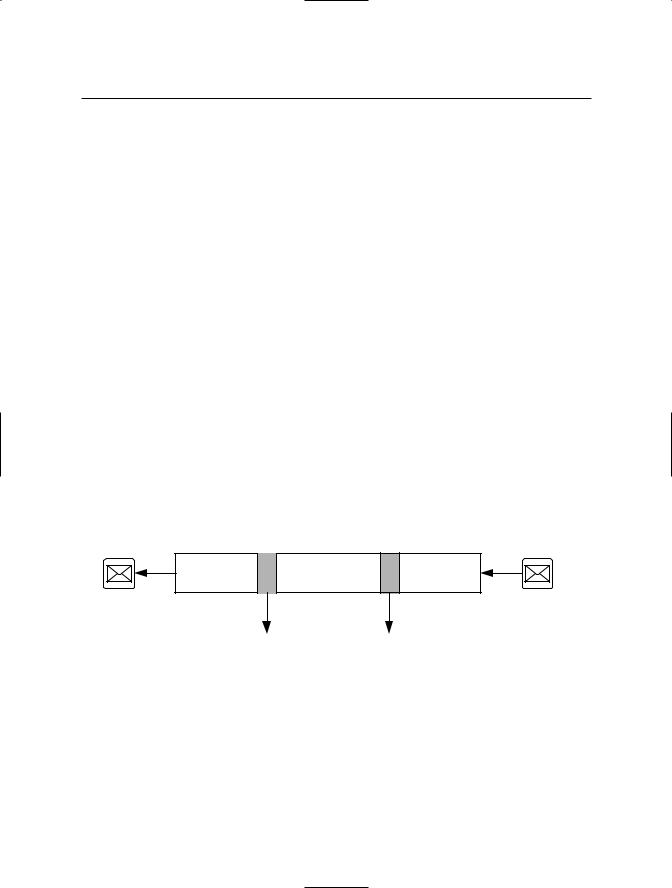
Expert Service-Oriented Architecture In CSharp 2005 (2006) [eng]
.pdf
216C H A P T E R 9 ■ B E YO N D W S E 3 . 0 : L O O K I N G A H E A D TO W I N D O W S C O M M U N I C AT I O N F O U N D AT I O N ( W C F )
Listing 9-6. Excerpt from the StockTrader Web Service WSDL File Showing the <service> and <binding> Definitions
<service name="StockTraderService">
<port name="StockTraderServiceSoap" binding="tns:StockTraderServiceSoap"> <soap:address location="http://localhost/StockTrader/StockTrader.asmx" />
</port>
</service>
<binding name="StockTraderServiceSoap" type="tns:StockTraderServiceSoap"> <soap:binding transport="http://schemas.xmlsoap.org/soap/http"
style="document" />
<operation name="RequestAllTradesSummary"> <soap:operation
soapAction="http://www.bluestonepartners.com/schemas/StockTrader/ RequestAllTradesSummary" style="document" />
<input>
<soap:body use="literal" /> </input>
<output>
<soap:body use="literal" /> </output>
</operation>
<!- Additional operations are not shown -> <operation />
</binding>
The WS-Addressing specification takes this concept one step further by encapsulating addressing, binding, and security policy information within a single reference, as shown in Listing 9-7.
Listing 9-7. Endpoint Reference XML
<wsa:EndpointReference>
<wsa:Address>soap.tcp://stocktrader.com/StockTrader</wsa:Address>
<wsa:ReferenceProperties>
<st:AccountID>123A</st:AccountID>
</wsa:ReferenceProperties>
<wsa:PortType>st:StockTraderSoap</wsa:PortType>
<wsp:Policy/>
</wsa:EndpointReference>
You can clearly see how the WCF Port object maps to familiar constructs such as endpoint references and the WSDL <service> and <binding> definitions.
The WCF Port object is tied into an extended processing pipeline that supports common message-processing features, including security, policy, routing, and transactions. When you write a service method, you need to add attributes for each of the specifications that you want to implement; for example, you can specify authorization access for a specific user or role.

C H A P T E R 9 ■ B E YO N D W S E 3 . 0 : L O O K I N G A H E A D TO W I N D O W S C O M M U N I C AT I O N F O U N D AT I O N ( W C F ) |
217 |
Assuming that the incoming message includes the right specification information, it will be routed through the Port object and into an extended processing pipeline. You can programmatically control the processing further by modifying property settings on one or more dedicated manager objects. For example, security processing is handled by the SecurityManager object.
Listing 9-8 provides a very simple example of a WCF service method, showing the annotations that you require for specifying basic authorization security processing.
Listing 9-8. A WCF Service Method Specifying Authorization Security Processing
[DatagramPortType(Name="PlaceTrader", Namespace="http://www.tempuri.org/quickstarts")]
public class Hello
{
[ServiceSecurity(Name = "Brokerage", Role = "Traders") ] [ServiceMethod]
public string PlaceTrade(string Account, string Symbol, int Shares, System.Double Price, TradeType tradeType)
{
// Code to execute trade not shown
return ("Your confirmation code is: " + TradeID);
}
}
This service must still implement a policy framework file to specify authentication security, such as encryption and digital signature requirements.
Typed Channels
A typed channel is similar to a Web service proxy object, which provides a typed object representation of the Web services WSDL interface. In a similar fashion, a WCF typed channel provides a typed object reference to a messaging endpoint and its associated operations.
In order to create a typed channel, you need to first create the Web service and define its methods. This in turn defines a WSDL interface, which you can then extract automatically (for example, you can append ?WSDL to the Web service URI in order to review the WSDL document). Finally, you can use a code-generation tool to generate a proxy class based on the WSDL file. Today, we have a utility called wsdl.exe. WCF ships with an equivalent utility called WSDLgen.exe.
The output of the code-generation utility is the typed channel, which provides a proxy representation of the WSDL interface as a managed object.
Service Manager
The Service Manager objects do all of the heavy lifting in processing messages and providing the support infrastructure for managing communications. Table 9-1 summarizes the important Service Manager objects and their purpose.

218 C H A P T E R 9 ■ B E YO N D W S E 3 . 0 : L O O K I N G A H E A D TO W I N D O W S C O M M U N I C AT I O N F O U N D AT I O N ( W C F )
Table 9-1. The WCF Service Manager Objects
Service Manager Objects |
Description |
ListenerManager |
Handles listener messages and performs the appropriate actions |
|
on the router service environment. Used in a user-mode listener |
|
implementation. |
PolicyManager |
Provides support for consuming, applying, processing, and generating |
|
policy on a specific port. |
RemotingManager |
Manages the WCF remoting infrastructure. |
RequestReplyManager |
Creates SendRequestChannel objects through which messages can be |
|
sent and replies received. |
RoutingPolicyManager |
Controls the consumption and application of routing and transport |
|
policy. |
RuleManager |
Represents the factory for rules, and through its namespace hierarchy, |
|
the associated properties. |
SecurityManager |
Controls application security requirements either programmatically or |
|
by using application and machine configuration files. |
ServiceManager |
Manages the associations between communication channels and |
|
service instances; registers services; and produces typed channels to |
|
make requests of other services. |
TransactionManager |
Represents the base class for a transaction manager. |
DialogManager |
Manages creation and deletion of the participants in a dialog. |
|
|
The Service Manager objects work with the Port object as extensions into a processing pipeline for incoming and outgoing messages. Service Managers automatically process messages as long as the associated service method has the appropriate annotations. Figure 9-2 shows the architecture of the port processing pipeline, including Service Managers.
The Port Processing Pipeline: Receive Channel
Processed Message |
Incoming Message |
RequestReplyManager RuleManager
Figure 9-2. The port processing pipeline architecture
Transports and Formatters
The transport and formatter layer is the low-level infrastructure that sits below the activity that is occurring in the port processing pipeline. You will rarely need to interact with the transport and formatter layer directly, beyond specifying what the service will support. You can also specify directional message transport information, such as whether a service is receive-only or is enabled for both send and receive operations.

C H A P T E R 9 ■ B E YO N D W S E 3 . 0 : L O O K I N G A H E A D TO W I N D O W S C O M M U N I C AT I O N F O U N D AT I O N ( W C F ) |
219 |
The transport and formatter layer is what enables messages to be moved across the wire. WCF supports a wide range of transport protocols, as shown in Table 9-2, which indicates the associated WCF object that abstracts the transport protocol information.
Table 9-2. WCF-Supported Transport Protocols
Protocol |
WCF Object |
HTTP |
HttpTransport |
POP3 |
Pop3Transport |
SMTP |
SmtpTransport |
SOAP |
SoapTransport |
TCP |
TcpTransport |
InProc |
InProcessTransport (on the same machine) |
CrossProc |
CrossProcessTransport (on the same machine) |
|
|
The transport and formatter layer delegates message serialization (and deserialization) to a dedicated object called the MessageFormatter, which is responsible for translating a byte stream between a formatted message and an in-memory Message object representation of the message.
How to Get Ready for WCF
Most developers are understandably ambivalent about a major upcoming release such as WCF. On the one hand, we welcome advancements in technology and the improvements in functionality and productivity that it will hopefully bring. On the other hand, we dread having to learn a new way of doing things, and we wonder whether we will be able to migrate our existing code to the new infrastructure.
These are valid concerns, especially with WCF. But the issue is less about WCF changing things than it is about things needing to change. Developers today are faced with multiple and often competing technologies for building distributed applications, including the classic choice between XML Web services vs. .NET Remoting. Certainly, there are cases where there is no overlap and no ambivalence and where one technology is clearly the better choice than another. But these technologies share too much in common to be treated differently. They are simply variations of the same technology. In the case of XML Web services and .NET Remoting, they are both concerned with remote distributed object and service invocation over a defined transport channel.
Microsoft is starting to address developer concerns by providing guidelines for how to get ready for WCF. It is already making sure to bring this topic up at professional conferences, and it will certainly continue to do so until the release of WCF. There has simply been too much investment in existing technologies for it not to.
WCF is obviously not a replacement for the entire set of .NET Framework functionality. Instead, it is focused on supporting distributed service-oriented applications with security, transaction support, and reliable messaging. WCF primarily extends four core technologies that are available today:

220C H A P T E R 9 ■ B E YO N D W S E 3 . 0 : L O O K I N G A H E A D TO W I N D O W S C O M M U N I C AT I O N F O U N D AT I O N ( W C F )
•ASP.NET Web services (built with .asmx pages)
•Web Services Enhancements (WSE)
•System.Messaging
•System.EnterpriseServices
Microsoft has stated that it will make the migration to WCF from current technologies a straightforward process. Here are some guidelines on how to get ready for WCF based on professional conferences, published white papers, and conversations with members of product development teams:
•Build services using .asmx pages.
•Use WSE 3.0 for additional, extended functionality, including security, policy, and secure conversation.
•Build qualified XML schema files for all custom data types used by the service.
•Use managed framework classes for integrating your services with MSMQ message queues and with COM+ components. Use the managed System.Messaging namespace for MSMQ, and the System.EnterpriseServices namespace for COM+ components.
•Avoid using the HTTP Context object in your .asmx pages.
•Avoid using .NET Remoting sinks and channels.
Given that WSE 3.0 is such an important part of this book, let’s look in more detail at how you can use the toolkit to prepare for WCF.
WSE 3.0 and WCF
WSE 3.0 allows developers to become early adopters of the next generation of service-oriented application technology. Every hour that you spend working with WSE 3.0 is an hour that you have contributed toward WCF. Applications that are built using WSE should migrate smoothly to the WCF framework, with only minor modifications required. If you choose to implement WSE today, then you should expect to accommodate changes to WSE between now and the release of WCF. It is unclear how many revisions WSE is expected to undergo prior to the release of WCF, but it is likely that we will only see service packs released, and they are not expected to negatively impact compatibility between WSE 3.0 and WCF. If anything, they should only make the compatibility tighter.
Table 9-3 compares the feature set of WSE 3.0 with WCF, based on current information provided by Microsoft.

C H A P T E R 9 ■ B E YO N D W S E 3 . 0 : L O O K I N G A H E A D TO W I N D O W S C O M M U N I C AT I O N F O U N D AT I O N ( W C F ) |
221 |
Table 9-3. Feature Comparison of WSE 3.0 and WCF
Feature |
WSE 3.0 |
WCF |
Hosting |
IIS/ASP.NET (.asmx) |
IIS/ASP.NET (.svc) |
|
SoapReceivers |
ServiceHost |
Programming Model |
[WebService], [WebMethod], etc. |
[ServiceContract], |
|
(supports interfaces, generics, |
[OperationContract], etc. |
|
and the like) |
(supports interfaces, generics, |
|
|
and so on) |
Message Exchange |
One-way |
One-way |
Patterns (MEP) |
Request-response |
Request-response |
|
Custom (using WSE API) |
First/last-operation |
|
|
Duplex |
|
|
Custom |
XML Serialization |
System.Xml.Serialization |
System.Runtime.Serialization |
|
|
System.Xml.Serialization |
|
|
(you can choose) |
Encodings |
XML 1.0 |
MTOM |
|
MTOM |
|
Custom |
XML 1.0 |
Binary |
|
MTOM |
|
Transports |
HTTP |
HTTP |
|
TCP |
TCP |
|
Custom |
Named pipes |
|
|
MSMQ |
|
|
P2P |
|
|
Custom |
Protocols |
Security |
Security |
|
|
Reliable messaging |
|
|
Transactions |
Behaviors (enabled |
Local DTC transactions |
Concurrency |
via attributes or |
HTTP buffering |
Instancing |
configuration) |
HTTP caching |
Throttling |
|
HTTP sessions |
Thread-binding |
|
Custom (via SoapExtensions, |
Exception handling and faults |
|
WSE filters) |
Impersonation |
|
|
Session management |
|
|
Transaction behaviors |
|
|
Custom (via behavior types) |
|
|
|
The main feature that is lacking in WSE 3.0 (compared to WCF) is that it does not provide wide system-level or infrastructure-level support for the enterprise aspect of service-oriented applications. Specifically, it does not provide support for transactions or reliable messaging.
Certainly, WSE 3.0 provides many of the required parts, but it does not provide the whole. For example, WSE 3.0 provides support for message addressing, and it also integrates with MSMQ via the System.Messaging namespace classes. So WSE 3.0 gives you the ability today to custom build a service-oriented application that implements “reliable” messaging (via MSMQ) and which can process message addressing information and provide message correlation. But this is not the same as a built-in support infrastructure that manages these tasks for you.

222 C H A P T E R 9 ■ B E YO N D W S E 3 . 0 : L O O K I N G A H E A D TO W I N D O W S C O M M U N I C AT I O N F O U N D AT I O N ( W C F )
These limitations are not a weakness of the WSE 3.0 technology. They simply underscore two things:
1.Infrastructure support for message-based, service-oriented architecture is most effectively handled at the operating system level.
2.WSE 3.0 allows early adopters to start designing and building their code for the future WCF infrastructure. More importantly, it gets developers thinking about application design in new ways. There is a large conceptual jump between traditional RPC-based applications and message-based, service-oriented applications.
With this being said, let’s review the major feature areas of WSE 3.0 (which you should by now feel very familiar with) and explain where they fit within the WCF framework:
Security and policy specifications: The WS-Security and WS-Policy specifications are supported by the WCF connector.
Messaging specifications: WCF provides Messaging services that subsume the functionality currently provided by MSMQ. In addition, it provides support for reliable messaging. WSE does not currently provide comprehensive support for the WS-Reliable Messaging specification, but it does provide some of the component parts that you can cobble together to approximate the specification. Specifically, WSE includes support for WS-Addressing, and it integrates with MSMQ via the managed System.Messaging namespace.
Routing and referral specifications: WCF includes these within its Messaging services functionality.
Alternate transport channels: WCF provides support for several transport channels, including HTTP, TCP, and IPC. WSE 3.0 currently provides support for the same three channels, so you can begin coding with them today.
In closing, we hope that this book has ultimately convinced you of three important things:
1.Message orientation and service orientation are the way to go.
2.WCF provides a welcome level of support for this technology, which will increase developer productivity and minimize confusion by unifying today’s disparate technologies.
3.WSE 3.0 is an excellent way for developers to become early adopters for WCF. Good luck with your future adventures in service-oriented architecture!

C H A P T E R 9 ■ B E YO N D W S E 3 . 0 : L O O K I N G A H E A D TO W I N D O W S C O M M U N I C AT I O N F O U N D AT I O N ( W C F ) |
223 |
Summary
WCF provides infrastructure and programming support for service-oriented applications. It is focused on messages and provides support for creating messages, for delivering messages, and for processing messages. With WCF, there is less ambiguity in your services: the infrastructure forces you to be message-oriented and to work with well-qualified XML-based data types.
WCF is built on five major areas:
The WCF service model: Provides support for processing incoming service request messages
The WCF connector: Provides support for communicating with services reliably and securely
Hosting environments: Provides several different hosting options for services
Messaging services: Provides reliable messaging support
System services: Provides a wide range of support infrastructure, including for transactions and trusted communications
WSE 3.0 allows early adopters to start building service-oriented applications today, using the next generation of service-oriented and message-oriented technologies. Working with WSE 3.0 provides you with excellent preparation for WCF. In addition, you should be familiar with Microsoft’s guidelines for how to tailor today’s development to be more compatible with WCF-based applications in the future.


A P P E N D I X
References
Here is a selection of references that you will find useful for learning more about SOA, the WS-I Basic Profile, the WSspecifications, and Web Services Enhancements. The references are broken out by topic. Note that Web services standards and specifications evolve quickly, so some of the specification references that are listed here will be superseded in future months by others.
Service-Oriented Architecture (General)
“Application Architecture for .NET: Designing Applications and Services” MSDN white paper (December 2002)
http://msdn.microsoft.com/library/default.asp?url=/library/en-us/dnbda/html/ distapp.asp
“Building Interoperable Web Services: WS-I Basic Profile 1.0” MSDN white paper (August 2003)
http://msdn.microsoft.com/library/default.asp?url=/library/en-us/dnsvcinter/html/ wsi-bp_msdn_landingpage.asp
“The Evolution of Web Services—Part 2” Adnan Masood
White paper (September 2003) http://www.15seconds.com/issue/030917.htm
“Java Modeling: A UML Workbook, Part 4” Granville Miller
White paper (June 2002) http://www-106.ibm.com/developerworks/java/library/j-jmod0604/
225
